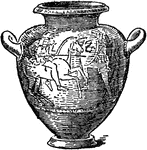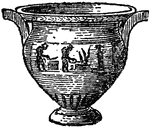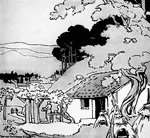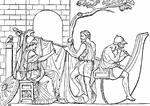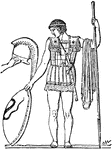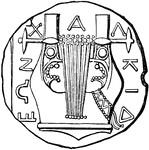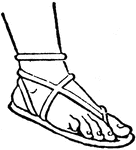
Sandal
"The Sandal is a protection for the foot, worn in ancient times. It was usually a sole of hide, leather,…
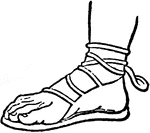
Sandal
"The Sandal is a protection for the foot, worn in ancient times. It was usually a sole of hide, leather,…

Sling and Slinger
"A Sling is a short leather strap having a string secured to each end, by which a stone is hurled."—(Charles…

Cardo
A hinge or pivot. The first figure, in the annexed woodcut, is designed to show the general form of…
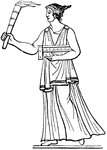
Cista
"A small box or chest, in which anything might be placed, but more particularly applied to the small…
Clavis
"A key. The key was used in very early times, and was probably introduced into Greece from Egypt; although…
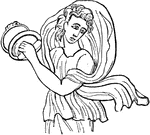
Cymbalum
"A musical instrument, in the shape of two half globes, which were held one in each hand of the performer,…

Discus
"A circular plate of stone or metal, made for throwing to a distance as in exercise of strength and…

Fastigium
"An ancient Greek or Roman temple, of rectangular construction, is terminated at its upper extremity…
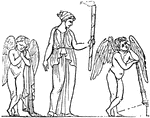
Fax
"A torch. In the annexed woodcut, the female figure is copied from a fictile vase. The winged figure…

Fibula
"A brooch, consisting of a pin, and of a curved portion furnished with a hook. The curved portion was…
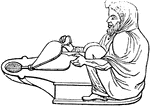
Follis
"Two inflated skins, constituting a pair of bellows. The following woodcut is taken from an ancient…
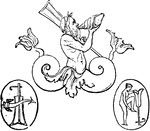
Gubernaculum
"A rudder. Before the invention of the rudder, which Pliny ascribes to Tiphys, the pilot of the ship…

Greek Chariot
"In the battles, as depicted by Homer, the chiefs are the only important combatants, while the people…

Foot-race
"The Olympic games were of greater efficacy than the Amphictyonic Council in promoting the spirit of…

Wrestling
"The Olympic games were of greater efficacy than the Amphictyonic Council in promoting the spirit of…
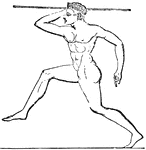
Hurling the javelin
"The Olympic games were of greater efficacy than the Amphictyonic Council in promoting the spirit of…
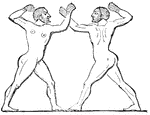
Boxing
"The Olympic games were of greater efficacy than the Amphictyonic Council in promoting the spirit of…

Tripod of Apollo
"It was the universal practice of the Greeks to undertake no matter of importance without first asking…
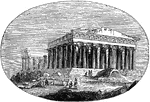
Modern Parthenon
"The Athenians, on their return to Attica, after the defeat of the Persians, found their city ruined…
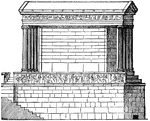
Temple of Nike Apteros
"The first public monuments that arose after the Persian wars were erected under the auspices of Cimon,…
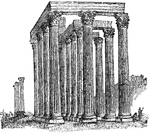
Temple of the Olympian Zeus
"Athens is said to have derrived its name from the prominence given to its worship of Athena by its…
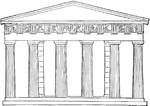
Thesium restored
"The Theseum is situated on a height to the north of the Areopagus, and was built to receive the bones…

Propylea restored
"A. Pinacotheca, B. Temple of Nike Apteros, C. Pedestal of Agrippa, D. Road leading to the central entrace,…

Parthenon restored
"The Parthenon stood on this highest part of the Acropolis, near its centre, and probably occupied the…

Erechtheum restored
"The building of the new Erechtheum was not commenced till the Parthenon and Propylea were finished,…

Bust of Pericles
"The enormous influence which Pericles exercised for so long a period over an ingenious but fickle people…

Bust of Aspasia
"Pericles, after divorcing a wife with whom he had lived unhappily, took his mistress Aspasia to his…
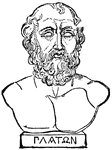
Bust of Plato
"Plato was born in Athens in 429 B.C., the year in which Pericles died. His first literary attempts…
!["Demosthenes had established himself as a public speaker before [the first Phillipic]; but it is chiefly in connection with Phillip that we are to view him as a statesman as well as an orator." — Smith, 1882](https://etc.usf.edu/clipart/16600/16602/demosthnbust_16602_mth.gif)
Bust of Demosthenes
"Demosthenes had established himself as a public speaker before [the first Phillipic]; but it is chiefly…

Coin of Alexander the Great
"Coin of Alexander the Great. Alexander, at the time of his father's death, was in his twentieth year,…

Bust of Homer
"Of the Homeric poems the Iliad and the Odyssey were the most distinguished and have alone come down…
